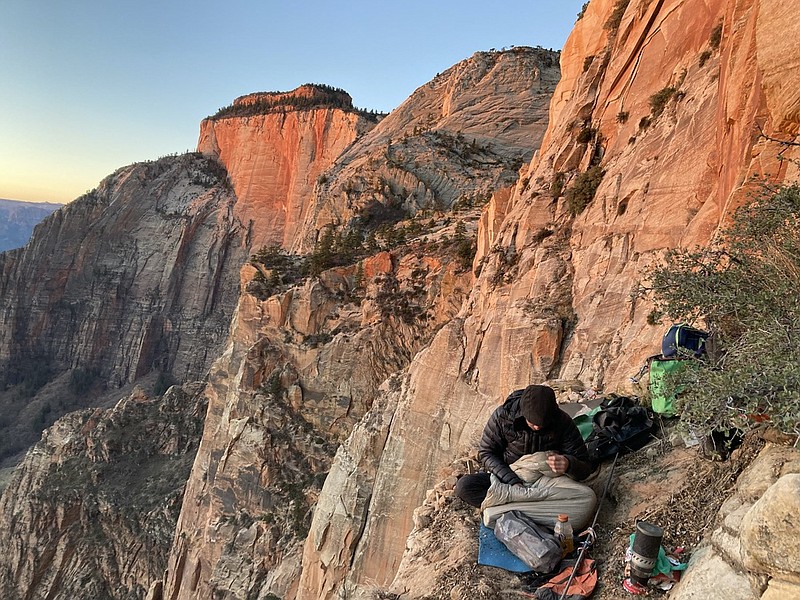When was the last time you did something new? Not just new to you, but something that has never been done before?
Just after Thanksgiving 2021, Ky Hart from Lafayette, Georgia, completed the first ascent of The Altar of Sacrifice's east wall. The Altar is the third tallest mountain in Zion National Park, at 7,505 feet. Its east wall is a 2,230-foot rock face near the mouth of Zion Canyon.
Aesthetically alluring with a left-leaning crack, the route was dubbed "Cowboy Killer" (VI 5.10 A4 X) by Hart and his climbing partner, Mike Dunn, since they spent their climb "living off adrenaline, cigarettes and sardines," the guys joke.
"The Altar's been high on our list and in the back of our minds for years," Hart explains. The east face of the Altar has seen many attempts, with none making it even to the halfway point. Evidence of these attempts haunts the route with over 600 feet of rotting rope and a variety of fixed gear along the way, most of which dates back to homemade, aluminum hangers from decades ago. The high point of these attempts is marked by two pull-tab Coors cans, seemingly from the 1980s, stashed on a ledge that Hart and Dunn nicknamed "Banquet Bivy" after they used the site as camp.
Both men started their careers as free climbers then transitioned to aid climbing, which uses the assistance of special equipment, helping make big walls like the Altar more accessible, as the crumbly, sandstone rock in Zion makes summiting especially difficult.
Hart and Dunn had their hearts set on the wall since they first laid eyes on it. Over the years, they pulled old topographic maps from the park archives, studying details down to how much gear is needed.
"We've been scheming this climb for years," says Hart, "but deep down, we've always been too scared."
By chance, Hart had previously met the man, Dan Stih, who first summited Altar, while he was serving beers at a bar just outside the park. Stih along with climber Ron Raimonde completed the first ascent of the mountain by way of its west face in 1997. They had placed a summit register, a small notebook in a weatherproof container, at the top to track if anyone else reached the summit. But the register hadn't seen another visitor - yet.
Then, on Thanksgiving Day 2021, after years of talk, Dunn called Hart letting him know he'd heard that another group of climbers was ready to take on the east wall.
If the two were going to get the first ascent, "It's now or never," Dunn said.
Hart got up from the table, leaving his dinner behind.
"I drove pedal to the metal in 'Tater,'" he said, referring to the small bus that doubles as his home, "stopping at every gear shop from Flagstaff to Zion to buy the gear needed to complete the climb."
Scrambling to make it to the top before the other group, Hart and Dunn covered the first two pitches at a quick pace. At the top of the second pitch, they reached a crack in which they couldn't fit gear - so they had to free climb, wedging their bodies into it and chimney-climbing up.
It was an X-rated pitch, underlining its seriousness. If they fell, they would fall 125 feet, which could be fatal.
But they got past the crack, and soon after, they reached the Coors cans. There, they dug out a little nook and slept hard.
The next few days were a mix of free and aid climbing on a fire-red section of the wall. On days four and five, the forested ledges were replaced by a steep crack.
"The rock was bad - it crumbled like a sugar cookie," says Dunn. "Ky would jug the line, and I cleaned it. [He] used gardening shears on the brush making a highway for the haul bags, but I blew a piece of gear and took an airy whipper just as the sun was setting."
Recovering quickly, they finished the pitch and drilled in their hanging tent for the night.
On day six, after a Southern breakfast of grits, Hart attacked the crux of the overhanging, soft stone. Eventually, he stretched their 60-meter rope to its end, drilled an anchor and fixed the line for Dunn to follow. Besides a light gear rack, bivy kit and stove, the team left most of their gear at this anchor, finishing their fifteenth pitch, and pushed for the top.
They reached it that evening and were greeted at the lip by a twisted ponderosa pine, a stone's throw from the first-ascent cairn built by Stih and Raimonde in 1997.
